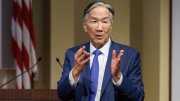The College today introduced changes in undergraduate aid—effective next fall, for the entering class of 2016—that reduce support for higher-income families and increase the income level at which students are able to attend Harvard at no cost, and simultaneously unveiled a financial-aid calculator for students and families. These changes, which follow other, similar alterations undertaken by some peer institutions, modify the very expansive liberalization of undergraduate financial aid unveiled in December 2007 (applicable to students enrolling in the fall of 2008)—coincidentally, just before the financial crisis and the subsequent savaging of the University’s endowment.
What’s New
As required by the Higher Education Opportunity Act of 2008, Harvard has created a "net price calculator," available at the financial-aid website, to enable applicants and their families to estimate their cost of attending the College, based on their financial circumstances. Built into the calculator are two important changes in financial aid that will begin in the fall of 2012:
- Families with incomes below $65,000 will pay nothing toward the cost of a child’s attendance—an increase from the current ceiling of $60,000. All students will benefit from this change starting next year: those currently enrolled, and those entering with the new class. (According to a chart on the financial-aid website, close to 1,200 scholarship students now in the College are from families with incomes of $60,000 or less.)
- Families with incomes from $65,000 to $150,000 will pay from 0 to 10 percent of income toward the cost of attendance, depending on their circumstances—as at present—but those enrolling with the class of 2016 and subsequent classes from families with incomes from $150,000 to $180,000 “will be asked to pay slightly more than 10 percent of income,” according to the College's news release. Currently, the upper bound is $180,000 (a level that remains in effect for students enrolled this year), so this change represents an increase in the cost of attending Harvard for future students whose family income exceeds $150,000. As the release notes, “Families at all income levels with significant assets will pay more, as under current policy.” The new formula, according to the Faculty of Arts and Sciences (FAS), means that families with incomes between $150,000 and $180,000 will now be asked to pay between 10 percent and 16.5 percent of income, depending on their assets (potentially raising the annual cost for the families at the top of this range from $18,000 to $29,700). According to the financial-aid website, slightly fewer than 600 families of students currently receiving scholarship aid have incomes between $140,000 and $180,000 (the figures are presented in $20,000 bands).
Thus, the College is, to a modest degree, redirecting its scholarship budget (a reported $166 million this academic year) from upper- to lower-income families. According to Jeff Neal, director, University communications (the principal news officer for FAS), "These adjustments help to meet heightened demand for aid precipitated by ongoing challenges in the United States and the global economies. Demand for aid is most acute at the lower end of the economic spectrum, and Harvard modified its policy and expanded its investment to respond to this need."
The Era of Expanding Aid
Harvard began its current approach to restructuring and liberalizing undergraduate financial aid in February 2004, when President Lawrence H. Summers announced that students from families whose income was less than $40,000 would attend the College for free (they had formerly paid an average of $2,300 per year; students remained responsible for contributing an additional $3,500 per academic year through outside scholarships, term employment, or loans, plus an average of $2,000 from summer earnings contributions), and those from families with incomes of $40,000 to $60,000 would have their share of costs reduced $1,250 on average. At the time, it was reported that the aid enhancements would cost the University about $2 million per year, raising the College scholarship budget to $80 million; the 2004-2005 term bill was $39,880.
In 2006, the zero-cost threshold was raised to $60,000, with family contributions reduced in the income range from $60,000 to $80,000.
Harvard raised the ante dramatically in December 2007, when President Drew Faust, Faculty of Arts and Sciences dean Michael D. Smith, and dean of admissions and financial aid William R. Fitzsimmons announced a $22-million boost in financial-aid spending for the 2008-2009 academic year (to approximately $120 million; the term bill for that year had risen to $47,215). The new policy featured:
- An income-based standard. Families with incomes from $60,000 to $120,000 per year would pay on a sliding scale, rising from 1 to 10 percent of income; those with incomes from $120,000 to $180,000 would pay 10 percent of income toward the cost of attending the College (resulting in a reduction of cost from $18,000 to $12,000 for those at the $120,000 level, and from $30,000 to $18,000 at the upper bound).
- No loans. By supplanting loans with increased grants, the College saved students from lower-income cohorts an estimated $1,000 per year.
- A home-equity exclusion. Finally, by excluding home equity from calculations of a family’s ability to pay, the expected contribution toward the cost of attending Harvard was reduced by another $4,000 per year.
That change accelerated a sort of aid free-for-all. Amherst, Davidson, and Williams announced plans to eliminate loans during 2007, emulating Princeton—and were promptly followed by Haverford, Penn, Swarthmore, and other institutions. Princeton excluded home equity from asset calculations, and Stanford sharply limited the amount of such equity included in those calculations. In the wake of Harvard’s sweeping liberalization of aid, Yale in early 2008 eliminated loans, too, and applied its own 10-percent-of-income formula to families with up to $200,000 of income (while maintaining an expectation of student contributions through work, outside scholarships, and summer earnings). Though not excluding home equity from asset calculations altogether, it did exempt the first $200,000 of family assets in assessing ability to pay (a possible benefit for renters) and included in the costs eligible for aid the expenses for a student’s travel to campus, books, supplies, and personal items.
New Fiscal Realities, Subsequent Revisions
The sharp increases in aid spending, of course, reflected the temper of the times: in late 2007 and early 2008, the value of endowments had mushroomed; institutions of higher education came under public pressure to spend more and, particularly, to buffer the increasingly onerous cost of attendance, especially for lower- and middle-income families.
Adjusting to the new realities, Yale—which had boosted spending from its endowment enormously, in part to accommodate the enhanced aid—subsequently restricted the range available for its 1-to-10-percent-of-income formula from families with incomes up to $200,000 to those with incomes up to $130,000, beginning with the 2010-2011 academic year; and student contributions rose from $2,600 to $3,000. Last December, it increased the ceiling for families from whom no contribution was expected to incomes of $65,000—the level Harvard College is adopting today. (Yale also announced that for students who enrolled this fall, self-help and summer earnings had been frozen at the prior-year level and that the need analysis for families with incomes above $130,000 would be adjusted somewhat.) Even with these changes, Yale said its spending on undergraduate scholarship aid would rise from $108 million last academic year to $117 million in the current one.
Other institutions that trimmed financial aid included Dartmouth, which reduced the income ceiling for loan-free aid, and Stanford, which reduced aid to families at the top income tier (above $200,000) and increased its expected student contribution.
As has proven the case at Yale since the modification of its aid program, FAS indicated that Harvard College's spending on financial aid is expected to increase even with the new scholarship parameters. Given that the term bill for tuition, room, and board will likely continue to increase (this year, the tab totals $52,652), spending on aid would have to expand just to keep pace with the resulting rising need (part of which aid, in turn, is funded by the unrestricted tuition funds the College collects).







